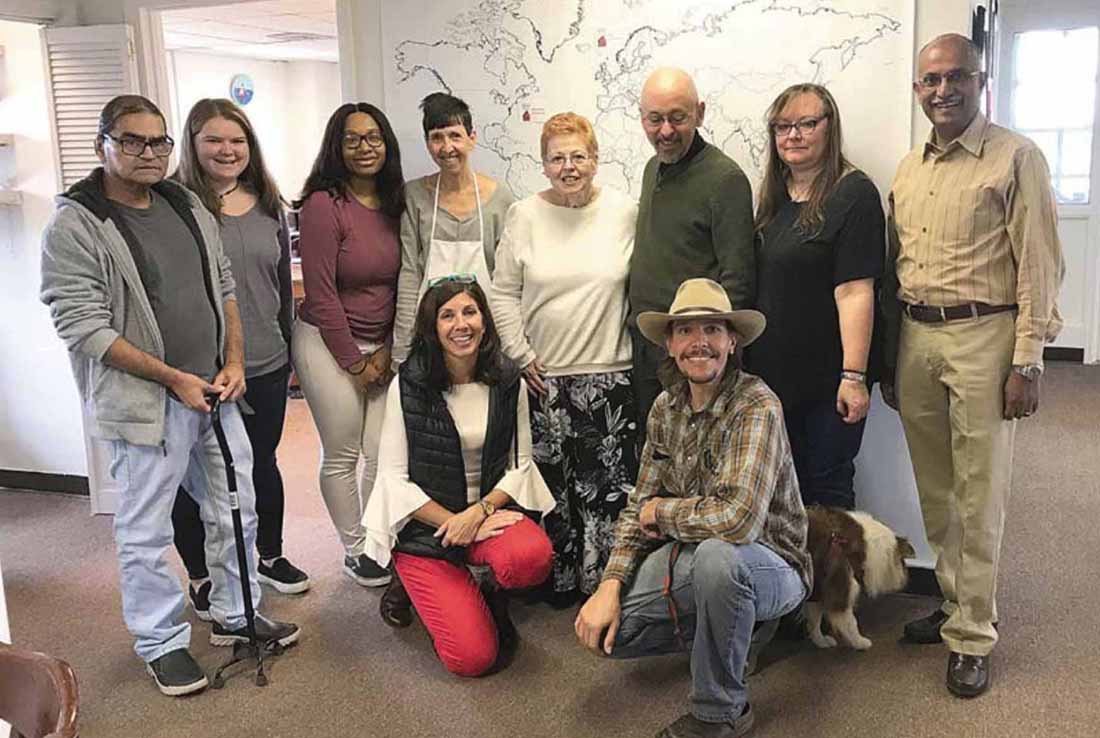At Shore House in Long Branch, mornings begin as they do in countless offices across the country, with staff meetings, list-making, task assignments, coffee breaks and camaraderie.
The work is the work of many offices: phones to be answered; visitors to be greeted; news to be researched, written and shared; plans to be made and milestones to be met.
The fourth floor office space at 279 Broadway is a welcoming place by intention and design, a place where people recovering from mental illness can step back into a social network and reclaim their balance in a complicated world.
Shore House is a member of Clubhouse International, a global network of nonprofits built on the foundational philosophy that those recovering from mental illness are full partners in their recovery, not passive consumers.
Today there are 200 clubhouses in North America and a total of 330 clubhouses worldwide.
Shore House is the only one in New Jersey. “We are the flagship club for New Jersey,” said board member and social worker Lou Storey, Psy.D. “We are really a model for all the other counties.”
The fact that there is a Shore House at all is due to the efforts of Rumson resident Susan Sandlass, who discovered the clubhouse model at the Fountain House in New York City while seeking help for a daughter suffering from bipolar disorder.
Sandlass became the founding president of Shore House in 2012. “She made this happen,” said Storey. “She brought the model here.”
Shore House board member Steven Theccanet, M.D., former chairman of the department of psychiatry at Monmouth Medical Center in Long Branch, was deeply familiar with the clubhouse model, having completed a fellowship at the Fountain House in New York City while studying at Columbia University.
When Sandlass contacted him about establishing a clubhouse here, he was fully supportive of the idea. “I knew what Fountain House was doing,” Theccanet said. “I felt this was great. The fact that I’d been in that role (at the Fountain House), I felt like I could do more. The goal would be to emulate Fountain House as much as possible.”
Shore House relies heavily on private donations for 90 percent of the $500,000 it needs annually to run its programs and pay its bills. “The only way we can exist is to so- licit private donations,” Theccannat said.
Membership is free to people living with mental illness and the connection is lifelong; once a member, you are always welcome back, Theccanat noted.
According to the National Institute of Mental Health, 1 in 5 Americans have a diagnosable mental disorder and 1 in 20 suffer from a severely disabling mental disorder such as schizophrenia or bipolar disorder. Statistics indicate that mental illnesses
are more common than cancer, diabetes and heart disease.
But unlike those conditions, mental illness comes with a stigma that can discourage people from seeking treatment and impede their recovery when they do.
For those unable to find effective solutions to their problems, the prognosis is grim. In any given hour, 100 people with
mental illness are dying by suicide.
The life span of someone with a persistent mental illness is 25 years shorter than average. In many cases, notes Theccanat, their conditions deteriorate due to preventable problems and treatable factors, like lack of access to nutritional food, isolation from the larger community and inability to seek medical care. The challenges they face include difficulty continuing their education, accessing medical care, finding and keeping a job and housing, isolation from a social network and feelings of worthlessness and lack of confidence that keep them from realizing the skills and talents they possess.
The clubhouse movement was conceived to address those realities with positive support, opportunities for paid employment, skills training and a social environment in which staff and members partner to operate the clubhouse and accomplish their personal goals. There are no white coats and no artificial barriers between members and staff.
It is the opposite of the “top-heavy” approach of traditional mental health structure in which the psychiatrist is the active member of a hierarchy and the patient is at the bottom, Theccanat noted.
“No meetings are conducted with closed doors,” he said. “It’s sometimes not really clear who is staff. In general, we work together as a team.”
Each clubhouse is founded on a “Bill of Rights” that incorporates the philosophy and outlines the operational guidelines for
the clubhouse. It’s posted prominently at Shore House, where executive director and social worker Susan Mazzeo says it’s referred to frequently when questions arise about the whos, whats, wheres and whys of managing the daily mission.
Each day, members of Shore House work on tasks that provide social interaction, bolster their confidence and sharpen their
skills. It’s not busy work, stresses Mazzeo.
Members receive assistance in preparing for and finding work in the community at large, where they do the same work and earn the prevailing wage as any other employee. A critical aspect of Mazzeo’s job is her outreach to potential employers who
may have a position a Shore House member is qualified to fill.
“It’s not busy work. It’s a real job,” Mazzeo stressed. “People become independent employees.”
Mary, a Shore House member who is a talented artist, said she’s found a community at the clubhouse that has helped her reconnect and rebuild her confidence. “It gave me a real family-friendly feeling,” she said. Representing Shore House at community events has also helped her overcome her fear of public speaking. “I can talk now. I’m not afraid of it anymore.”
Her confidence grew further when a few of her watercolors were snapped up by patrons at the organization’s “Art of Recovery” gallery show and at St. George’s Canterbury Fair in Rumson. After seeing her work, one man went to an ATM, came right back and bought one of her watercolors. She’s working on getting cards she’s designed into local stores.
“It’s wonderful to see them blossom,” said Thecannat. “To see them go from passive to active.”
Members of Shore House are now looking forward to moving their offices into a renovated house on Broadway early next
year. Members will have their own kitchen to prepare the family-style meals that take place both regularly and on holidays, and they’ll be able to have a garden as well.
Once the conversion is complete, it will extend the feeling of homecoming that Shore House inspires in its members and
staff. They hope to make the move to the new location in March 2020.
Sunday, Oct. 20, members of Shore House will gather at Rumson Country Club for their “Beacon of Hope” fundraiser honoring Shore House supporters Mary Jane and Rick Kroon, Long Branch Mayor John Pallone and musician Bobby Bandiera.
Learn more about Shore House and purchase tickets to their event online at shore-clubhouse.org.




